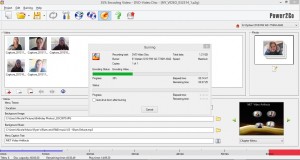It’s been on my to-do list for weeks, but I finally experimented with the DVD authouring task accessed through the ETEC565a eLearning Toolkit.
The DVD authouring software bundled on my laptop is called Power2Go, and it’s the only such software I’ve ever tried. It took some time to find the software – My OS is Windows 8, and I couldn’t find the program on the Windows 8 tile interface, with a word search for DVD, by inserting a blank DVD into the drive, or by right-clicking video files and trying to use the “open with” function. I knew the software was on my machine, though, because I remember seeing it at some point or another (possibly a desktop shortcut when I first bought my laptop). Finally, I searched Google for the make and model of my laptop and found the name of the software.
I wanted to create a DVD with the video artifacts I’ve created with MET. To ensure I had the final copy of the final projects, I downloaded the .mp4 files from my YouTube account. However, when trying to add them to my project, I found that Power2Go does not support .mp4 files. I don’t currently have a filetype converter installed on my laptop, so I used some of the raw files used to create my final projects instead.
The Power2Go software was easy enough – the process was not laborious. There was only one theme available for DVD projects, titled “Vacation,” and although it didn’t suit my initial project concept, the fact that I was experimenting with raw files anyways made the point moot. I was able to title my project (for reading by the DVD player), create a menu, choose music and make a slideshow. The interface was user-friendly and posed no great challenge, it would be suitable for a beginner. I tested the disc on a DVD player and TV at my place of employment, because I have neither of those electronic items at my home. The DVD worked just as expected. The title of the DVD, chapter names, and file names were as I had written using the Power2Go software, despite displaying their filenames on the computer interface.
I chose five videos for this DVD, totaling 1.21 GB or about 14 minutes and 10 seconds of video content. The DVD-R used had a stated capacity of 4.78GB. On the disc itself, it says it has a capacity of two hours, but I was surprised to see that the software interface indicated a capacity of 60 minutes. I’m not entirely sure where the difference comes into play. In addition, I was surprised to see that even on maximum speed, the DVD took 40 minutes to burn. I’m not sure if this ratio scales at all with different amounts of content – for a person wanting to burn 60 minutes of content, would it take 160 minutes or 2.6 hours? If I reflect back to the ETEC565a scenario with Anju and her 60-minute diabetes workshop to burn on DVD, and it seems to me that the length of time per disc to burn could be prohibitive for a person like her who was a part-time employee.
Overall, I found it relatively simple to create an interactive DVD with features such as menu, images, music, slideshow; the general items we expect to see on a DVD. It was not a challenging task, although if I were serious about wanting to create DVDs for my clients, I would explore some other software options to see if I could find an offering with more relevant themes, and if other software products were less time-intensive for the burning aspect.


DVD burning is more intensive than CD burning because of the spaced required for video/audio versus video only. Because you started with mp4 files your burning software will recode those in the proprietary DVD video format (v0b I believe). If you were burning a a high definition Blu-Ray disc, that uses a different format as well, which takes even longer!
Burning the first disc takes a long time; however copying that first disc to other discs should be faster than doing a “fresh” burn each time. But yes, it can be time consuming. 🙂
Ah! The extra time for conversion/encryption makes sense.
The Power2Go version bundled with my computer didn’t actually support the .mp4 filetype, although I see that more recently released versions of the software do. The files I burned were .wmv – no big deal. I could see it being a confusion for someone who wasn’t too familiar with filetype extensions, software versions, and those types of things. I guess that’s another area that Anju’s helpful neighbour could chime in 🙂